and the distribution of digital products.
State of IoTeX Q4 2024
- Following the launch of IoTeX 2.0, average daily transactions on the IoTeX Network surged 1,267% QoQ to 384,300, with peak throughput reaching 62 tps in Q4 2024.
- Total fees accrued on the IoTeX Network grew by 205% QoQ to $448,500, driven by a 1,600% increase in gas fees and a 690% rise in DEX fees, primarily from activity on Mimo.
- IoTeX advanced the integration of AI and DePIN by introducing BinoAI, an autonomous agent built on ai16z’s ELIZA framework. IoTeX announced a partnership with Eliza Labs to drive the creation of DePIN-AI agents to perceive and act in physical environments through DePIN data.
- IoTeX released Quicksilver, a middle-layer framework to connect DePIN data to AI agents, and ioID, a universal onchain identity solution for smart devices that bridges the physical and digital worlds.
- IoTeX V2.1 launched in December, introducing Cancun EVM compatibility, ensuring enhanced functionality and Ethereum interoperability.
IoTeX (IOTX) is a modular infrastructure platform that supports developers of decentralized physical infrastructure networks (DePIN). By integrating advanced AI capabilities, IoTeX bridges the physical and digital worlds, enabling smart devices and decentralized applications (dapps) to interact with blockchains. The IoTeX network combines its EVM-compatible Layer-1 (L1) blockchain, offchain compute mid-layer, and open hardware to connect real-world data from devices, machines, and sensors with onchain ecosystems.
The IoTeX L1 utilizes a Randomized Delegated Proof-of-Stake (Roll-DPoS) consensus mechanism. Anyone can stake the network’s native token (IOTX) and vote for one or more community-elected delegates who manage consensus on behalf of the IoTeX Network.
IoTeX’s latest product release, Quicksilver, introduces a framework for integrating DePINs with AI agents. Quicksilver enables real-time data processing, adaptive responses, and AI-driven interactions with the physical world. DePINs function as “sensory organs” for AI agents, leveraging decentralized networks of IoT devices to collect and share real-world data. These devices provide continuous data streams verified using ZK proofs, allowing AI agents to sense, interpret, and respond to their environments. The first iteration of Quicksilver has been released as an open-source project, with the official testnet launch expected in Q1 2025.
At the core of Quicksilver is ioID, a decentralized identity (DID) protocol that transforms hardware devices—such as smart devices and sensors—into onchain entities with verifiable identities. The ioID protocol enables trust, interoperability, and secure agent-to-agent communications. It also plays a key role in orchestrating blockchain-based AI agent swarms, where multiple specialized agents collaborate to solve complex problems.
Quicksilver’s modular design enhances scalability and verifiability. The framework supports applications like BinoAI, a DePIN-oriented AI agent built on Quicksilver, which connects to various DePIN projects for use cases ranging from smart cities to precision agriculture. For a full primer on IoTeX, refer to our Initiation of Coverage report.
Website / X (Twitter) / Telegram
Key Metrics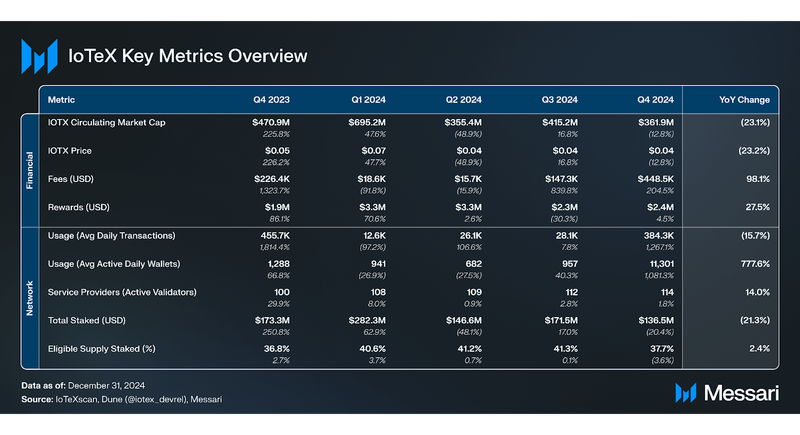 Network Overview
Network OverviewThe IoTeX Network connects supply and demand:
- Supply: IoTeX L1 provides DePIN-focused blockspace and an ecosystem to DePIN projects and other dapps. IoTeX also supports the entire lifecycle of projects by providing infrastructure, public goods, and governance tools through DePIN Infrastructure Modules (DIMs). This is offered in a modular, end-to-end tech stack that connects real-world data to the blockchain world.
- Demand: Consumers of blockspace on IoTeX L1 and DePIN-focused middleware/tooling. These are primarily DePIN projects but also projects in the DeFi and GameFi sectors.
Demand for the IoTeX L1 blockspace comes from more than 120 dapps in need of data streaming and offchain compute capabilities. The real-world data is sourced primarily from smart devices, machines, and sensors.
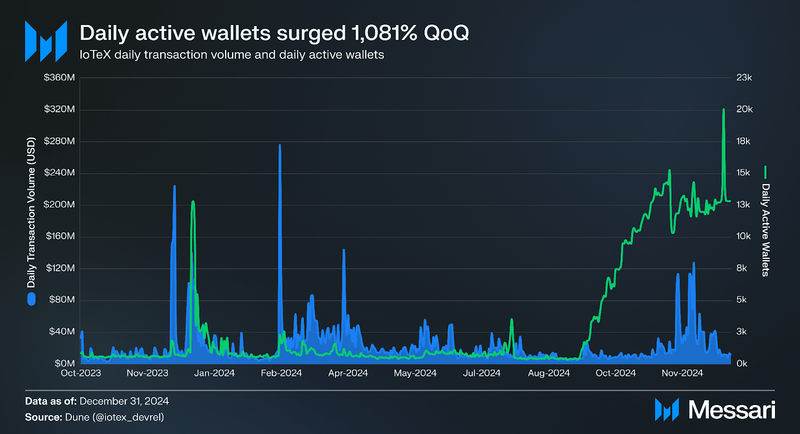
Average daily active wallets on the IoTeX Network surged 1,081% QoQ from 957 to 11,301 in Q4. The recent increase may be attributed to the launch of the ioID infrastructure protocol on November 20.
As part of the IoTeX 2.0 launch, the ioID protocol aims to manage the decentralized identity lifecycle in DePIN. The ioID protocol is IoTeX’s onchain identity solution to issue Decentralized Identities (DID) and Verifiable Credentials (VC) to physical hardware. In simple terms, ioID turns hardware devices (e.g., smart devices, machines, and sensors) into onchain entities with a verifiable identity. The ioID protocol is also used within the Quicksilver framework to register AI agents with an AI agent registry on the blockchain, unlocking peer-to-peer agent communication as well as decentralized management of agent swarms by DePIN projects
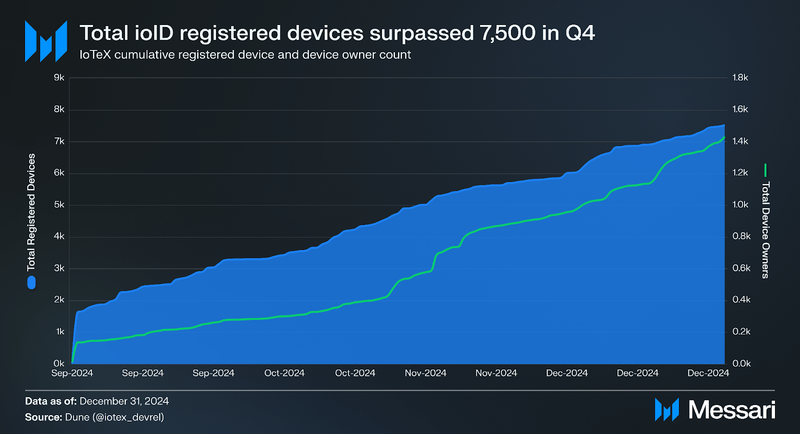
As of the end of Q4 2024, 7,500 ioID identities were registered and verified onchain by 1,500 device owners. Miners and community members can reserve ioIDs to bootstrap DePIN networks.
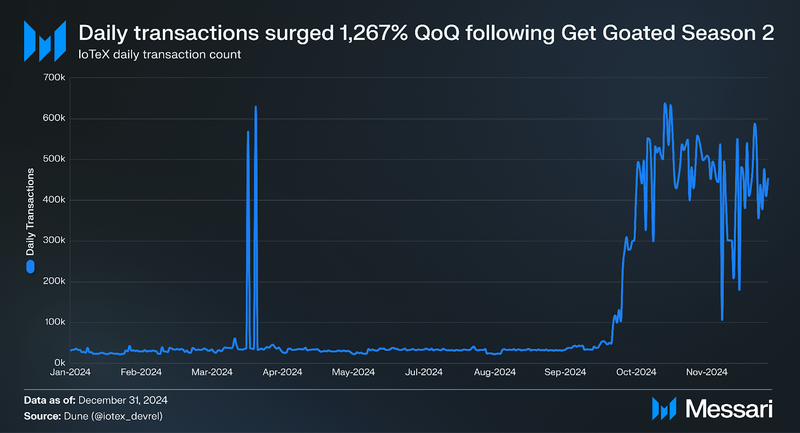
Following the launch of IoTeX 2.0, the onboarding of new ioIDs, and the start of the Get Goated Season 2 incentive campaign in October, activity on the IoTeX Network surged 1,267% QoQ from 28,100 to 384,300 in terms of the average daily transactions, with an average of 62 peak transactions per second throughout Q4.
Staking OverviewStaking represents a core component of decentralized governance on the IoTeX Network. Holders of the native IoTeX token — IOTX — deposit the token to support network operations, consensus, and governance. If token holders stake their IOTX tokens, they can vote for delegates to manage consensus on their behalf.
Tokenholders earn IOTX rewards in return for staking. Simultaneously, IoTeX 2.0 has inflationary staking rewards to boost the amount of IOTX staked and increase network security. The community decides the inflation rate, aiming for mild inflation that offers competitive staking rewards APRs. Gas fees paid in IOTX are burned, correlating it to the amount of network activity.
In addition, the ioID protocol requires IOTX tokens to be burned to create new onchain identities for devices, with this burn rate being dynamic based on the total number of registered devices. Other actions in the ioID protocol require burning IOTX, such as obtaining verifiable credentials (VCs) for decentralized identification (DIDs) and linking device identities to the IoTeX L1 and other decentralized infrastructure modules (DIMs).
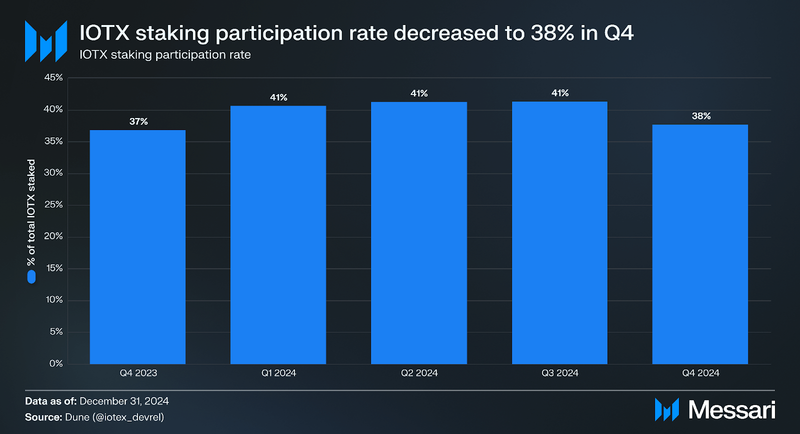
As of December 31, 2024, the IoTeX Network was secured by 114 active delegates, with $137 million (3.6 billion IOTX) staked—a 20% QoQ decrease. Staking participation averaged 38% in Q4 2024, down from its all-time high in Q3.
Financial OverviewFees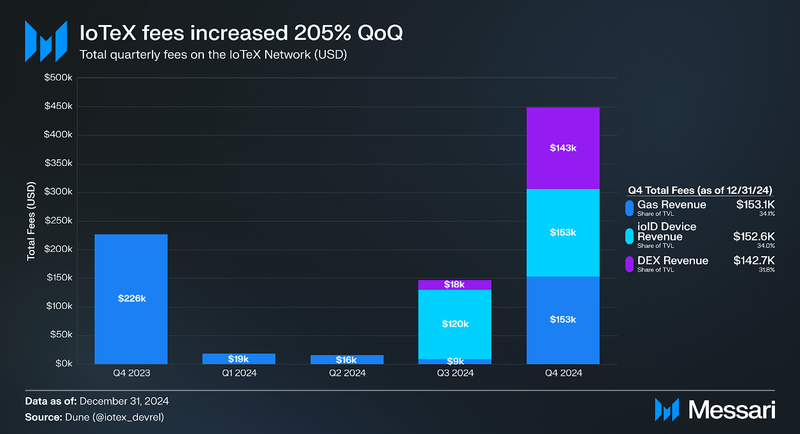
Total fees accrued by the protocol capture the demand side of the IoTeX Network:
- Gas fees: paid in IOTX by anyone initiating a transaction on the IoTeX Network, similar to Ethereum's transaction fee structure.
- Activation fees: paid upon activating an ioID device.
- DEX fees: paid in IOTX when using the Mimo decentralized exchange (DEX) as part of the DePIN Liquidity Hub program.
Total fees accrued on the IoTeX Network increased by 205% QoQ, reaching $448,500 in Q4 2024. This growth was primarily driven by a substantial rise in gas fees, which grew 1,600% QoQ from $9,000 to $153,000, and DEX fees, which increased by 690% QoQ from $18,000 to $143,000, largely due to activity on Mimo. ioID device activation fees experienced more moderate growth than these revenue streams, rising 28% QoQ from $120,000 to $153,000.
RewardsIoTeX leverages token incentives to deploy and maintain a community-contributed infrastructure network. Rewards are paid to validators on the IoTeX network from new token issuance.
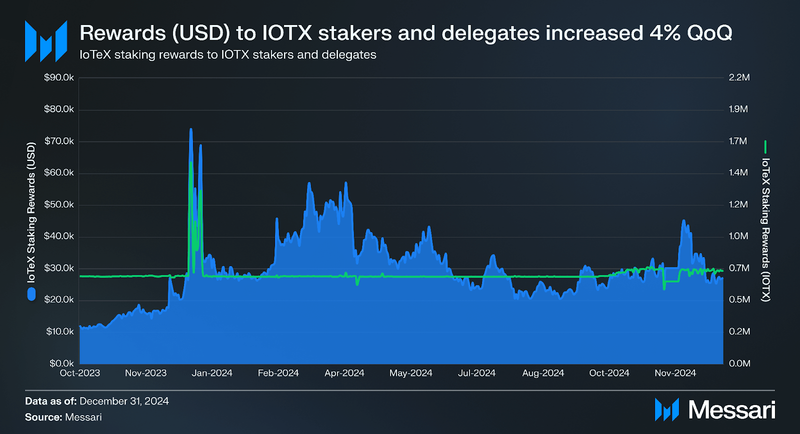
In Q4 2024, rewards to IOTX stakers and delegates increased by 4% QoQ to $2.4 million. In IOTX terms, rewards decreased 6% QoQ from 60.6 million IOTX in Q3 to 57.2 million IOTX in Q4.
Ecosystem OverviewThe IoTeX ecosystem currently has 251 projects, including 66 DePIN projects. The number of DePINscan projects increased by 5% QoQ, from 281 to 295. The number of devices using DePINscan increased by 8% QoQ, from 18.1 million to 19.6 million. Messari’s State of DePIN 2024 sector report indicates that IoTeX is one of the most mature DePIN L1 ecosystems, leading Q4 transaction activity among dedicated L1s-for-DePIN, which are carving out their own native onchain ecosystems.
DePIN projects building on IoTeX utilize DePIN Infrastructure Modules (DIMs) such as ioID, W3bstream, Quicksilver, or choose the IoTeX L1 for token launches. DePIN use cases include connected smart vehicles, geo-mapping, energy data tracking, health platforms, and proof-of-presence and proof-of-humanity apps. Besides DePIN, use cases on the IoTeX ecosystem include AI, DeFi, GameFi, and NFTs.
Partnerships and IntegrationsIoTeX collaborated with numerous dapps, exchanges, and crypto entities during Q4 2024. Below is a summary of the partnerships and integrations established during the quarter:
- On October 2, IoTeX partnered with Nubila, a data oracle specializing in ESG (Environmental, Social, and Governance) data for the DePIN ecosystem. Nubila aims to create a network of advanced weather stations to capture critical environmental data.
- On October 14, IoTeX partnered with Streamr, a decentralized data streaming network that provides censorship-resistant messaging, node operation, and tamper-proof encrypted data. This integration combines Streamr’s real-time data protocol with IoTeX’s DePIN infrastructure to enable faster and smarter data flow in DePIN applications.
- On October 16, IoTeX partnered with Starpower, a decentralized energy network startup focused on scaling Distributed Energy Resources (DERs) using proprietary hardware and software solutions like the Starplug smart plug. Starpower is integrating IoTeX’s ioID to enhance DePIN verification.
- On October 16, IoTeX partnered with Avalon Labs, a company focused on integrating centralized and decentralized finance (CeDeFi) services. Avalon Labs offers products such as a Bitcoin-backed stablecoin, onchain lending platforms, and yield-generating savings accounts.
- On October 19, IoTeX partnered with Apro Oracle, a decentralized oracle network providing secure and accurate data services tailored for Bitcoin projects. This partnership enhances smart contract capabilities and enables broader application scenarios within the IoTeX ecosystem.
- On November 3, IoTeX partnered with DePIN Institute to integrate users into decentralized infrastructure networks through familiar devices such as smart home systems, wearable devices, and augmented reality equipment.
- On November 5, IoTeX partnered with the OKX Wallet, enabling 50 million global users to trade IoTeX assets natively within the OKX DEX.
- On November 6, IoTeX partnered with Orbiter Finance, a ZK-powered Ethereum L2 network backed by OKX Ventures. The partnership aims to enhance security and scalability within the Ethereum ecosystem.
- On November 15, IoTeX partnered with BitBot, a non-custodial Telegram trading bot that leverages AI to provide advanced trading tools and market insights, making these accessible to retail investors.
- On November 21, IoTeX partnered with Geodnet to integrate its Geo-Pulse device with IoTeX’s ioID for onchain identity and W3bstream for ZK proofs. Geo-Pulse, designed for installation on vehicle dashboards, delivers lane-level positioning with over 10x the accuracy of standard GPS or smartphone systems. Drivers can earn GEOD and IOTX rewards by contributing verified coverage data through the device.
- On December 5, IoTeX partnered with Jasmy, a blockchain-based platform, creating a decentralized Internet of Things (IoT) ecosystem where users control access to their data via the Personal Data Locker and share it selectively for JASMY rewards.
- On December 5, IoTeX partnered with the Blockchain Association, a leading U.S. crypto trade association based in Washington D.C., focused on advancing supportive policies and regulations for cryptocurrency.
- On December 19, Inferix secured $2.6 million from DePIN X Capital, which is backed by IoTeX, to develop a Decentralized GPU Network for AI training and visual computing.
- On December 27, Roam launched its Discovery Ecosystem, a platform supporting early-stage innovative projects. IoTeX is a key partner, alongside Huma Finance and Mind Network, contributing to initiatives spanning L1, PayFi, and AI sectors.
The convergence of AI and DePIN has the potential to redefine how computational resources are distributed, network participation is incentivized, and infrastructure ecosystems are democratized. Their relationship will likely be symbiotic, as DePIN networks contribute verifiable, crowdsourced data that can be leveraged to train AI models. At the same time, AI can optimize the operations of DePIN devices by automating resource allocation, predicting network demands, and increasing revenue potential for device owners. IoTeX, focusing on verifiable DePIN infrastructure, is well-positioned to serve as a key enabler of this emerging intersection between AI and DePIN.
Eliza x BinoAIIn Q4 2024, IoTeX made notable progress in integrating AI with its ecosystem by introducing BinoAI, an autonomous AI agent launched on December 19. Built on ai16z’s open-source ELIZA framework and deployed on the IoTeX network, BinoAI specializes in the DePIN ecosystem. Its primary role is to autonomously share knowledge and insights, from simplifying complex DePIN concepts to highlighting new projects and achievements in the space. BinoAI aims to foster a more informed and connected DePIN community by engaging users through educational content and social interactions. Additionally, BinoAI leverages IoTeX L1’s blockchain functionality to securely access and interact with onchain data, enhancing its ability to deliver relevant and actionable insights.
The introduction of BinoAI represents the first step toward the broader application of AI agents in the DePIN ecosystem. Future development could see the emergence of industry-specific AI agents tailored to specialized DePIN applications. For example, mobility-focused agents could optimize decentralized logistics and manage autonomous vehicles, while energy-specific agents might streamline renewable energy grids and enable efficient energy trading systems. Similarly, agents designed for wearables could provide personalized health insights and biometric security, and those tailored for smart homes could manage decentralized devices, security systems, and energy consumption. These AI agents could simultaneously enhance user engagement and improve the interaction experience with DePIN networks.
To further advance this vision, IoTeX, and Eliza Labs, the creators of ElizaOS and ai16z, announced a strategic partnership focused on empowering autonomous AI agents with the ability to perceive and interact with the physical world through DePIN networks.
This collaboration seeks to bridge the gap between digital intelligence and real-world sensory data, accelerating progress toward AI agents that can interact with and learn from their physical environments. By integrating data from IoTeX-powered DePIN networks, such as Nubila (weather data), Geodnet (geospatial positioning), and Pebble Tracker (GPS, motion, and temperature data), AI agents will be able to harness real-time data streams and act autonomously.
Key areas of collaboration between IoTeX and Eliza Labs include the integration of a DePIN plugin for ElizaOS. This plugin will be a critical layer, allowing Eliza agents to retrieve and process real-world data from IoTeX’s DePIN networks. With access to this data, AI agents can gain contextual awareness, enabling them to develop predictive capabilities and adaptive behaviors based on historical and real-time inputs. These enhancements will improve decision-making and expand the applicability of AI agents in real-world scenarios, from robotics and smart devices to urban management in smart cities. The partnership also empowers developers by providing access to IoTeX’s modular DePIN tools through Eliza Labs’ AI Agent Dev School. This initiative includes workshops, tutorials, and technical guides designed to help developers integrate DePIN capabilities into AI workflows, further fostering innovation in the ecosystem.
The collaboration between IoTeX and Eliza Labs represents a significant step in integrating AI and DePIN, with implications that could reshape the future of autonomous agents. The development and application of AI in this context will remain a key area to watch throughout 2025 as IoTeX advances its role at the forefront of this intersection.
QuicksilverIoTeX also announced the launch of a new DIM, Quicksilver, scheduled for an official Testnet release expected by Q1 2025. Quicksilver is a sentient AI framework for bridging DePIN and AI Agents. Quicksilver empowers developers to build AI agents capable of sensing, understanding, and acting within the physical world. By leveraging DePINs as a sensory layer, these agents can collect and process data from decentralized physical infrastructure, such as weather stations, energy grids, or geospatial networks. With this real-world data, agents integrate advanced reasoning capabilities from large language models (LLMs) to perform context-aware actions and automate multi-step workflows while maintaining state and context. The framework’s modularity enables AI agents to interact with multiple DePIN projects simultaneously, drawing from diverse data sources to enhance adaptability and utility.
Quicksilver is powered by three key modules and three supporting plugins/tools. The Identity Module provides AI agents with onchain and offchain identities, enabling secure and trust-based interactions with network participants, including smart devices, services, or other agents. Onchain identities simplify the management of crypto assets and ownership, while offchain identities support secure agent-to-x communications. The Blockchain Wallet Module enables AI agents to engage in the agent economy by managing transactions onchain, leveraging account abstraction to simplify Web2-based authentication for managing crypto assets. The Verifiable Computing Module ensures the trustworthiness of program execution in AI agents, guaranteeing reliable responses when processing queries or interacting with other entities.
In addition to these modules, Quicksilver includes three plugins/tools to extend the capabilities of AI agents. The DePIN Adapter Plugin facilitates connections to various DePIN projects, enabling agents to access and interact with decentralized physical infrastructure. The Blockchain Plugin equips agents with the ability to query onchain data, enhancing decision-making based on real-time blockchain activity. Finally, the Verifiable Computing Plugin allows agents to access external verifiable computing services via API calls, ensuring data integrity and reliability in their operations.
The convergence of DePINs and AI agents heralds a new era of synergy between artificial intelligence and the physical world. By combining decentralized infrastructure with intelligent automation, Quicksilver has the potential to push the boundaries of technological innovation while enhancing real-world applications, from urban living to industrial efficiency. As DePINs continue to expand, Quicksilver paves the way for AI agents that are more capable and deeply attuned to the complexities of our physical reality.
ioID LaunchCopilot Insights: What is ioID?On November 20, 2024, IoTeX announced the release of ioID, a universal onchain identity solution for smart devices. Designed to bridge the physical and digital worlds, ioID provides decentralized identity and ownership mechanisms for devices within the IoTeX ecosystem. The ioID architecture combines several components, including the ioID SDK, decentralized identifiers (DIDs), the IoTeX Hub, ioID NFTs, and smart contracts deployed on IoTeX’s L1. These elements form a framework for managing device identities, securing data, and enabling verifiable device interactions.
At the core of ioID’s architecture is its DID system. When a device is powered on, a DID is created along with a corresponding DID document. The private key for the DID is securely stored on the device, enabling it to sign and verify any data and activities produced by the device. The IoTeX Hub, a web portal, facilitates user registration by binding a device’s DID to its ioID NFT, creating an onchain identity. Device owners must deposit IOTX to cover fees for smart contract interactions required to activate the ioID. Once activated, the ioID NFT is minted and represents the onchain ownership of the device. The NFT enables its holder to manage the device’s data, perform onchain actions, and collect rewards tied to the device’s activity.
The ioID solution is underpinned by a suite of smart contracts on the IoTeX blockchain, which collectively manage the decentralized identity lifecycle. These include:
- ioID Registry for onchain device registration and identity resolution.
- Project Registry for managing DePIN projects.
- ioID NFT for issuing unique device identities.
- ioID Store for activating and managing identities.
These smart contracts ensure that ioIDs are verifiable, programmable, composable, and tamper-proof, aligning with IoTeX’s broader goal of creating a chain-agnostic identity framework.
ioIDs are also equipped with their own smart contract wallets and private keys, allowing them to sign data and verify real-world activities. They integrate with IoTeX’s DePIN Infrastructure Modules (DIMs), enabling secure data storage and computation. The upcoming W3bstream platform will further enhance this by leveraging ZK proofs to verify data from ioID devices. These mechanisms make ioID a powerful identity solution for DePIN projects, ensuring device authenticity and fostering trust across the ecosystem.
Throughout 2024, IoTeX conducted testing of ioID with over 10 DePIN projects, including Geodnet, Network3, and Envirobloq. These collaborations helped standardize ioID’s offering, making it a universal identity solution tailored to the requirements of the DePIN sector. IOTX deposit fees will be burnt, staked, or dispersed to ecosystem-owned token pools like the Marshall DAO and Roll-DPoS rewards pool. The goal of ioID tokenomics will be to incentivize DePIN projects to adopt ioID, reduce the total supply of IOTX via deflationary burn in proportion to ioID registrations, and reward users that opt-in to verify their DePIN devices' identity and activity.
ioID unlocks significant potential for the DePIN ecosystem by enabling verifiable device identities. This capability allows DePIN projects to ensure the authenticity and trustworthiness of devices contributing to their networks. As a result, end users may become more willing to pay for data or services from DePIN projects, exchanges may feel more confident listing DePIN tokens, and regulators could craft more meaningful legislation tailored to the sector.
Beyond these broad benefits, ioID introduces new primitives for DePIN builders. One example is authorization and access control, where devices with ioIDs can be issued verifiable credentials to ensure only specific devices or owners interact with smart contracts, dapps, or mining rewards.
ioID's programmability also allows for fractional ownership and financing of devices, enabling complex ownership hierarchies. For instance, a device’s principal and cash flows could be split among multiple owners who contribute to financing, installation, or maintenance, supporting DePIN projects’ supply-side growth.
Additionally, ioID NFTs open opportunities for lending, borrowing, and trading devices. As ioIDs are represented onchain as NFTs, they can be traded or used as collateral in lending arrangements. This could enable scenarios where device installers sell pre-installed devices to passive investors or DePIN miners to access liquidity by lending their ioID NFT and associated cash flows to others. These innovations position ioID as a foundational technology for advancing DePIN infrastructure and creating new economic models within the DePIN ecosystem.
To realize a blockchain-orchestrated DePIN agent swarm, all AI agents must register their ioIDs with an AI agent registry on the blockchain. Leveraging the Quicksilver framework, the AI agent registry contains each agent’s onchain and offchain identities and their role and specialty. The coordinator agent monitors the AI agent registry and updates its knowledge each time a new DePIN agent joins the swarm. By resolving an agent’s DID, the coordinator agent can obtain its DID document and then find its service endpoint.
W3bstreamCurrently, W3bstream is live on its Devnet, with IoTeX targeting the launch of the Testnet in Q1 2025. This milestone will mark a significant step in providing developers with scalable and verifiable computing infrastructure to build and innovate in the DePIN sector.
W3bstream is a verifiable compute protocol designed to validate the real-world activities and data produced by devices in the DePIN ecosystem. By leveraging ZK proofs, W3bstream ensures the trustworthiness and provenance of data before it is settled onchain. This approach provides a critical layer of reliability for DePIN builders, enabling them to confirm the accuracy of metadata and real-world data from devices.
As a permissionless and chain-agnostic computing engine, W3bstream will be the foundation for Proof of Utility use cases within DePIN networks. For example, in renewable energy DePINs, W3bstream can ingest data directly from energy-producing hardware, such as solar panels, and generate validity proofs. These proofs allow anyone to independently verify the amount of energy produced by a specific device or the entire DePIN network. This level of verifiability enhances transparency and trust for stakeholders across DePIN applications.
Once live W3bstream is natively integrated with ioID, it will be able to process signed data from ioID-equipped devices. This integration ensures end-to-end device identity and utility verifiability, further strengthening DePIN ecosystems' integrity.
Incentive InitiativeOn October 29, 2024, IoTeX, in collaboration with OKX, Gate, and other DePIN projects, launched the Get Goated Season 2 campaign. This initiative spans three months, concluding on January 29, 2025, and is designed to incentivize users to participate in DeFi and DePIN-related tasks across selected protocols. Participants can deepen their engagement with the DePIN ecosystem by completing these tasks while earning substantial rewards. The rewards pool for Get Goated Season 2 includes 100 million IOTX tokens and $2 million in contributions from 20 DePIN projects. Participants earn campaign-specific credits called BinoBits by completing eligible activities. Each user’s proportional share of BinoBits, relative to the total awarded during the campaign, determines their share of the overall rewards. The distribution of rewards is divided into two primary categories. 70% of the IOTX rewards, equivalent to 70 million tokens, are allocated for task-based incentives. These tokens are distributed based on the BinoBits users earn through eligible activities. The remaining 30%, or 30 million IOTX, is set aside for liquidity pool farming incentives distributed through farming on Mimo and iZUMi.
The campaign features activities across 9 DeFi protocols, encouraging users to participate in trading, liquidity provision, staking, asset bridging, and referral programs. For example, liquidity providers can add liquidity to specific trading pairs on Pinswap. Staking is available on protocols such as Bedrock and Loxodrome, while participants who bridge assets to IoTeX receive additional BinoBits, with bonus rewards for the first ten bridges each day. A referral program also incentivizes participants to invite others to join the campaign using unique referral links. In addition to DeFi activities, 20 DePIN projects are participating in the campaign, contributing a total of $2 million in DePIN tokens.
As the campaign concludes on January 29, 2025, IoTeX and its partners will distribute the rewards. This process includes enabling users to convert points earned from Galxe social tasks into BinoBits and allocating rewards based on the BinoBits earned by participants. As of January 15, 2025, the top three protocols in terms of BinoBits distributed are IoTeX staking, Mimo, and ioPay.
Technology UpgradesThe Q4 upgrades to the IoTeX L1 continued the network’s evolution following the IoTeX 2.0 upgrade in Q3. IoTeX 2.0 established a modular infrastructure for DePIN development, designed to support a wide range of participants, including dapps, traditional companies, and small development teams. This modular architecture features components like DePIN dapps, pre-built DePIN Infrastructure Modules (DIMs) such as ioID and W3bstream, a Modular Security Pool (MSP) secured by IOTX, and the IoTeX L1 itself.
In Q4, IoTeX prioritized updates to improve compatibility, performance, and functionality. On October 15, the Cancun EVM compatibility upgrade was approved with unanimous community support. This update introduced EIP-4844 for blob transactions, a critical feature for ZK application integrations, along with new EVM instructions to maintain compatibility with the latest versions of the Solidity compiler. These changes strengthened IoTeX’s interoperability with the Ethereum ecosystem and supported the growing demand for ZK-enabled applications.
Several incremental updates to IoTeX Core were released throughout the quarter. Versions 2.0.5, 2.0.6, 2.0.7, and 2.0.8 addressed minor fixes and performance improvements, such as resolving minting inefficiencies and API node issues. While these updates contributed to network stability, the most significant development in Q4 was the release of IoTeX Core V2.1.
IoTeX Core V2.1 was introduced on December 3 and activated through a hard fork on December 17, with all node operators required to update before the upgrade. This release implemented Cancun EVM compatibility, integrating EIP-4844 for blob transactions, EIP-1559 for dynamic fee transactions, and EIP-2930 for access list transactions. These enhancements significantly improved the network’s ability to process advanced transaction types and strengthened its alignment with Ethereum’s evolving standards. In addition to feature upgrades, v2.1 resolved critical bugs, including ensuring accurate clearing of staking bucket amounts after unstaking and setting staking duration limits to prevent indefinite staking periods.
Closing SummaryIn Q4 2024, IoTeX achieved significant growth, with average daily transactions surging 1,267% QoQ to 384,300 and total fees increasing by 205% QoQ to $448,500, fueled by the launch of ioID and the Get Goated Season 2 incentive campaign. The introduction of ioID in November established a universal onchain identity solution for smart devices, unlocking advanced DePIN use cases such as verifiable device identities and fractional ownership.
IoTeX also advanced AI integration with BinoAI, an autonomous agent powered by the ELIZA framework, and a strategic partnership with Eliza Labs to enable AI agents to leverage DePIN data in real-world applications. Key partnerships, including Nubila for ESG data and Streamr for decentralized data streaming, expanded IoTeX’s ecosystem. The IoTeX Core v2.1 upgrade delivered critical functionality such as Cancun EVM compatibility, positioning the network for continued innovation in DePIN and AI-driven infrastructure.
- Home
- About Us
- Write For Us / Submit Content
- Advertising And Affiliates
- Feeds And Syndication
- Contact Us
- Login
- Privacy
All Rights Reserved. Copyright 2025, Central Coast Communications, Inc.